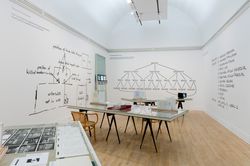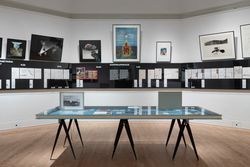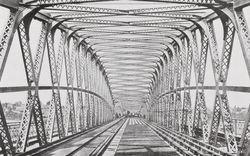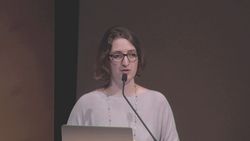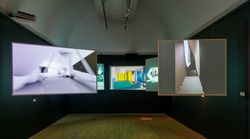The Other Architect
For as long as architecture has been reduced to a service to society or an “industry” whose ultimate goal is only to build, there have been others who imagine it instead as a field of intellectual research: energetic, critical, and radical. From a set of varied approaches drawn from many people, places, and times, the other architect emerges: searching for different(...)
28 October 2015 to 10 April 2016
The Other Architect
Actions:
Description:
For as long as architecture has been reduced to a service to society or an “industry” whose ultimate goal is only to build, there have been others who imagine it instead as a field of intellectual research: energetic, critical, and radical. From a set of varied approaches drawn from many people, places, and times, the other architect emerges: searching for different(...)
Series
AP181.S1
Description:
Series 1, BMW Welt development and construction records, 1994-2015, documents the design development and construction phases of COOP HIMMELB(L)AU BMW Welt building, located nearby the BMW headquarters in Munich. This series also contains some materials from the competition phase, corresponding to less than 2000 digital files, and models from the third phase of the competition. More than half of the records were created from 2003 to 2006. Records show how COOP HIMMELB(L)AU, and the numerous consultants on the project, materialized the original concept, from Wolf Prix sketch, of this cloud-like roof emerging from a double cone suggesting an hurricane eye. To achieve this, extensive digital structural testing was done with engineers Bollinger + Grohmann. Consultants list also include: - Hans Lechner ZT GmbH for in-house project management; - Schmitt, Stumpf, Frühauf + Partner for construction documents of concrete works, interior fittings, tender and construction administration; - Emmer Pfenninger + Partner AG for the facade; - Transsolar, Klima Engineering for the photovoltaic plant on the roof; - PRO, Elektroplan for electrical systems and lifts; - AG-Licht for lighting; - Büro Dr. Pfeiler for structural physics or building physics; - Theater Projekte Daberto+Kollegen for the stage and auditorium; - PBB Planungsbüro Balke for kitchen technology - realgruen Landschaftsarchitekten for lansdcape design; - Kersken & Kirchner for fire protection; - TAW Weisse for height accessibility planning, in consideration for maintenance access; - Lang & Brukhardt for traffic engineering; - Ingenieurbüro Schoenenberg for civil engineering and road construction; - Büro für Gestaltung / Wangler & Abele for signage; - And Zilch, Müller, Henneke as inspection engineers. The approximately 52,400 digital files include raster images, CAD drawings and 3D digital models, plotter files, standard office documents, databases, and scripts. Design files are predominantly in AutoCAD, but the archive also includes over 1,100 Rhinoceros files (primarily in Rhino version 2, with some files in versions 3 and 4) and a smaller number of files in Maya, 3D Studio, Microstation, form*Z, and Revit formats. Because the firm’s computing environment included Macs, the archive also includes a few AppleDouble resource forks. Often, CAD drawings were also saved as PDF files. Photographs and screen captures were most times saved as JPEG files. Finally, design files also include wireframes and renderings. Most often, design files are plans of a designated area, a complete level of the building for example, but they also often show very specific and technical details, such as a few millimetres to be corrected on a panel or a structural element. These types of corrections are frequently shown in PDF files where annotations were either made digitally, or they were handwritten on a printed version which would then be digitized. Design files document all parts of the building including the facade, the roof, the double cone (Doppelkegel), the restaurants, the shops, the exhibition areas, the auditorium, etc. Accompanying textual records are at times quite technical in their content, such as lists of construction elements required in a given room, or analysis reports from consulting engineers. They also take into account the organization and planning of the work, for example including documentation’s exchange or meeting agendas. Finally, they show the design development through presentations, either PDF or Powerpoint files, and through a portfolio of the project and the preparation of the book Dynamic Forces. The archive’s physical component includes 52 physical study models, which were used in combination with digital modeling tools to iteratively refine the building’s design. These are a selection made by the firm of study models from the later stages of the competition and the early stages of the design development. Source: Feireiss, Kristin, editor. “Dynamic Forces, BMW WELT Munich”. Munich: Prestel Verlag, 2007.
1994-2015
BMW Welt development and construction records
Actions:
AP181.S1
Description:
Series 1, BMW Welt development and construction records, 1994-2015, documents the design development and construction phases of COOP HIMMELB(L)AU BMW Welt building, located nearby the BMW headquarters in Munich. This series also contains some materials from the competition phase, corresponding to less than 2000 digital files, and models from the third phase of the competition. More than half of the records were created from 2003 to 2006. Records show how COOP HIMMELB(L)AU, and the numerous consultants on the project, materialized the original concept, from Wolf Prix sketch, of this cloud-like roof emerging from a double cone suggesting an hurricane eye. To achieve this, extensive digital structural testing was done with engineers Bollinger + Grohmann. Consultants list also include: - Hans Lechner ZT GmbH for in-house project management; - Schmitt, Stumpf, Frühauf + Partner for construction documents of concrete works, interior fittings, tender and construction administration; - Emmer Pfenninger + Partner AG for the facade; - Transsolar, Klima Engineering for the photovoltaic plant on the roof; - PRO, Elektroplan for electrical systems and lifts; - AG-Licht for lighting; - Büro Dr. Pfeiler for structural physics or building physics; - Theater Projekte Daberto+Kollegen for the stage and auditorium; - PBB Planungsbüro Balke for kitchen technology - realgruen Landschaftsarchitekten for lansdcape design; - Kersken & Kirchner for fire protection; - TAW Weisse for height accessibility planning, in consideration for maintenance access; - Lang & Brukhardt for traffic engineering; - Ingenieurbüro Schoenenberg for civil engineering and road construction; - Büro für Gestaltung / Wangler & Abele for signage; - And Zilch, Müller, Henneke as inspection engineers. The approximately 52,400 digital files include raster images, CAD drawings and 3D digital models, plotter files, standard office documents, databases, and scripts. Design files are predominantly in AutoCAD, but the archive also includes over 1,100 Rhinoceros files (primarily in Rhino version 2, with some files in versions 3 and 4) and a smaller number of files in Maya, 3D Studio, Microstation, form*Z, and Revit formats. Because the firm’s computing environment included Macs, the archive also includes a few AppleDouble resource forks. Often, CAD drawings were also saved as PDF files. Photographs and screen captures were most times saved as JPEG files. Finally, design files also include wireframes and renderings. Most often, design files are plans of a designated area, a complete level of the building for example, but they also often show very specific and technical details, such as a few millimetres to be corrected on a panel or a structural element. These types of corrections are frequently shown in PDF files where annotations were either made digitally, or they were handwritten on a printed version which would then be digitized. Design files document all parts of the building including the facade, the roof, the double cone (Doppelkegel), the restaurants, the shops, the exhibition areas, the auditorium, etc. Accompanying textual records are at times quite technical in their content, such as lists of construction elements required in a given room, or analysis reports from consulting engineers. They also take into account the organization and planning of the work, for example including documentation’s exchange or meeting agendas. Finally, they show the design development through presentations, either PDF or Powerpoint files, and through a portfolio of the project and the preparation of the book Dynamic Forces. The archive’s physical component includes 52 physical study models, which were used in combination with digital modeling tools to iteratively refine the building’s design. These are a selection made by the firm of study models from the later stages of the competition and the early stages of the design development. Source: Feireiss, Kristin, editor. “Dynamic Forces, BMW WELT Munich”. Munich: Prestel Verlag, 2007.
Series
1994-2015
photographs
PH1981:0772:001-227
Description:
Album of photographs showing views and monuments of german towns, mostly churches, castles, houses, streets, monnuments, museums and rivers. The cities shown are Munich, Wurzburg, Regensburg, Augsburg, Ulm, Stuttgart, Heidelberg, Bamberg, Nurnberg, Halberstadt, Munster, Strassburg, Speier, Worms, Wetzlar, Limburg, Marburg, Koln, Bonn, Karlsbad, Dresden, Berlin, Potsdam, Leipzig, Magdeburg, Braunschweig, Schwerin, Hamburg, Stendal, Doberan and Lubeck. Some views are from Prague, Czechoslovakia (now Czech Republic).
architecture
1870s-1880s
Album of photographs showing views of Germany and of Prague (Czech Republic)
Actions:
PH1981:0772:001-227
Description:
Album of photographs showing views and monuments of german towns, mostly churches, castles, houses, streets, monnuments, museums and rivers. The cities shown are Munich, Wurzburg, Regensburg, Augsburg, Ulm, Stuttgart, Heidelberg, Bamberg, Nurnberg, Halberstadt, Munster, Strassburg, Speier, Worms, Wetzlar, Limburg, Marburg, Koln, Bonn, Karlsbad, Dresden, Berlin, Potsdam, Leipzig, Magdeburg, Braunschweig, Schwerin, Hamburg, Stendal, Doberan and Lubeck. Some views are from Prague, Czechoslovakia (now Czech Republic).
photographs
1870s-1880s
architecture
Alongside a growth in decentralized, experimental, and underground cinema at the end of the 1960s and in the early 1970s, many groups operating from inside the field of architecture such as Superstudio, Studio 9999, and Ant Farm explored the short film as a medium to expand architectural discourse, embed their projects with bold reflections and projections of society, and(...)
Octagonal gallery
21 September 2018 to 19 May 2019
Scripts for a new world
Actions:
Description:
Alongside a growth in decentralized, experimental, and underground cinema at the end of the 1960s and in the early 1970s, many groups operating from inside the field of architecture such as Superstudio, Studio 9999, and Ant Farm explored the short film as a medium to expand architectural discourse, embed their projects with bold reflections and projections of society, and(...)
Octagonal gallery
articles
20th century, Alfred Gotthold Meyer, Allemagne, Deutscher Werkbund, engineering, Friedrich Naumann, Germany, ingénierie, Ingenieur-Ästhetik, Joseph August Lux, Karl Marx, Katherine Romba, Munich, Rudolf Metzger, William Morris, XXe siècle
14 October 2010
archives
Level of archival description:
Collection
J.J.P. Oud Collection
CI005
Synopsis:
The J.J.P. Oud Collection, 1911-1973, documents J.J.P. Oud's work as an architect between 1911 and 1973. The collection is focussed on Oud’s architectural projects, including work on major exectued and unrealized buildings in the Netherlands, Germany, Czechoslovakia, and the United States. The collection also includes Oud's designs for diverse projects on public housing, war memorials and interior design.
1908-1966 (1911-1963 predominant)
J.J.P. Oud Collection
CI005
Synopsis:
The J.J.P. Oud Collection, 1911-1973, documents J.J.P. Oud's work as an architect between 1911 and 1973. The collection is focussed on Oud’s architectural projects, including work on major exectued and unrealized buildings in the Netherlands, Germany, Czechoslovakia, and the United States. The collection also includes Oud's designs for diverse projects on public housing, war memorials and interior design.
archives
Level of archival description:
Collection institutionnelle
1908-1966 (1911-1963 predominant)
On New Year’s Eve 1987, the people of Gonaïves, an impoverished port town on Haiti’s west coast, awoke to 4,000 tons of toxic ash. Amidst political turmoil in Haiti, officials had approved the import of toxic waste from the United States classified as “fertilizer.” In this case, the ash came from Philadelphia, which was facing a waste management crisis brought on by the(...)
Canada, environment, Jodoin, Müller, It's all happening so fast, toxic, Haiti, voluntary exchange, garbage imperialism, Gonaives
16 March 2017
Here It Is Toxic, There It Is Not
Actions:
Description:
On New Year’s Eve 1987, the people of Gonaïves, an impoverished port town on Haiti’s west coast, awoke to 4,000 tons of toxic ash. Amidst political turmoil in Haiti, officials had approved the import of toxic waste from the United States classified as “fertilizer.” In this case, the ash came from Philadelphia, which was facing a waste management crisis brought on by the(...)
Canada, environment, Jodoin, Müller, It's all happening so fast, toxic, Haiti, voluntary exchange, garbage imperialism, Gonaives
archives
Level of archival description:
Fonds
AP075
Synopsis:
The Cornelia Hahn Oberlander fonds documents Oberlander's professional activities as a landscape architect. It contains over 203 projects that span from 1950 to 2018 predominantly in Canada and in the United States, but also in Germany. The fonds is a complete record of Oberlander's work, and comprises her playground projects, roof gardens, and public space landscapes, as well as landscape designs for private residences, as well as administrative records from her practice, her professional engagements, and her research materials. The material in this fonds is dated from 1936 to 2021.
1936-2021
Cornelia Hahn Oberlander fonds
Actions:
AP075
Synopsis:
The Cornelia Hahn Oberlander fonds documents Oberlander's professional activities as a landscape architect. It contains over 203 projects that span from 1950 to 2018 predominantly in Canada and in the United States, but also in Germany. The fonds is a complete record of Oberlander's work, and comprises her playground projects, roof gardens, and public space landscapes, as well as landscape designs for private residences, as well as administrative records from her practice, her professional engagements, and her research materials. The material in this fonds is dated from 1936 to 2021.
archives
Level of archival description:
Fonds
1936-2021
Design for a Stage Set
DR1987:0070
Description:
- This drawing is typical of Desprez's designs for flat-wing stage sets. Flanking what would have been a large painted canvas set at the back of the stage (here decorated with antique buildings on the slope of a hill) are two rows of façades receding into the distance. These buildings were painted on a series of wooden wings placed in grooves or runners at intervals on each side of the stage. In more elaborate theatres, the wings attached directly to machinery housed below the stage. The wings could be moved easily in these runners, either manually or mechanically, thus facilitating swift changed of scenery. Desprez's use of the flat wing system may still be seen, in a number of stage sets, executed after his designs, that survive in the theatre in Drottingholm (see plates IX and X in M. Baur-Heinhold, 'Teatro Barocco', Munich, 1971)
theatre design
late 18th century
Design for a Stage Set
Actions:
DR1987:0070
Description:
- This drawing is typical of Desprez's designs for flat-wing stage sets. Flanking what would have been a large painted canvas set at the back of the stage (here decorated with antique buildings on the slope of a hill) are two rows of façades receding into the distance. These buildings were painted on a series of wooden wings placed in grooves or runners at intervals on each side of the stage. In more elaborate theatres, the wings attached directly to machinery housed below the stage. The wings could be moved easily in these runners, either manually or mechanically, thus facilitating swift changed of scenery. Desprez's use of the flat wing system may still be seen, in a number of stage sets, executed after his designs, that survive in the theatre in Drottingholm (see plates IX and X in M. Baur-Heinhold, 'Teatro Barocco', Munich, 1971)
theatre design
Archaeology of the Digital: Complexity and Convention is the third exhibition related to the development of a strategy for collecting and preserving digital archives at the CCA. The Archaeology of the Digital program comprises twenty-five projects for which digital materials are integral to an understanding of the design process. For projects included in the first two(...)
11 May 2016 to 16 October 2016
Archaeology of the Digital: Complexity and Convention
Actions:
Description:
Archaeology of the Digital: Complexity and Convention is the third exhibition related to the development of a strategy for collecting and preserving digital archives at the CCA. The Archaeology of the Digital program comprises twenty-five projects for which digital materials are integral to an understanding of the design process. For projects included in the first two(...)
